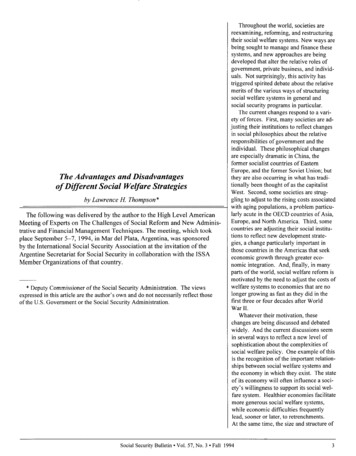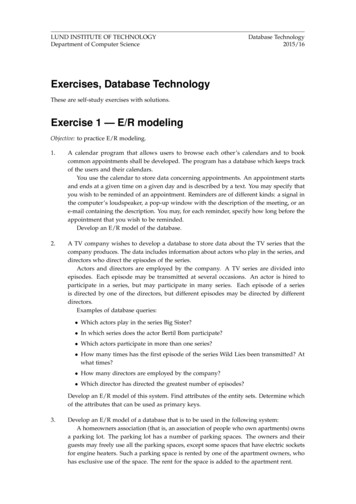
Transcription
The Advantages and Disadvantagesof Different Social Welfare Strategiesby Lawrence H. Thompson*The followingwas delivered by the author to the High Level AmericanMeeting of Experts on The Challenges of Social Reform and New Administrative and Financial Management Techniques. The meeting, which tookplace September 5-7, 1994, in Mar de1 Plata, Argentina, was sponsoredby the InternationalSocial Security Associationat the invitation of theArgentine Secretariat for Social Security in collaboration with the ISSAMember Organizationsof that country.* Deputy Commissioner of the Social Security Administration.The viewsexpressed in this article are the author’s own and do not necessarily reflect thoseof the U.S. Government or the Social Security Administration.Social Security BulletinlThroughout the world, societies arereexamining, reforming, and restructuringtheir social welfare systems. New ways arebeing sought to manage and finance thesesystems, and new approaches are beingdeveloped that alter the relative roles ofgovernment, private business, and individuals. Not surprisingly, this activity hastriggered spirited debate about the relativemerits of the various ways of structuringsocial welfare systems in general andsocial security programs in particular.The current changes respond to a variety of forces. First, many societies are adjusting their institutions to reflect changesin social philosophies about the relativeresponsibilities of government and theindividual. These philosophical changesare especially dramatic in China, theformer socialist countries of EasternEurope, and the former Soviet Union; butthey are also occurring in what has traditionally been thought of as the capitalistWest. Second, some societies are struggling to adjust to the rising costs associatedwith aging populations, a problem particularly acute in the OECD countries of Asia,Europe, and North America. Third, somecountries are adjusting their social institutions to reflect new development strategies, a change particularly important inthose countries in the Americas that seekeconomic growth through greater economic integration. And, finally, in manyparts of the world, social welfare reform ismotivated by the need to adjust the costs ofwelfare systems to economies that are nolonger growing as fast as they did in thefirst three or four decades after WorldWar II.Whatever their motivation, thesechanges are being discussed and debatedwidely. And the current discussions seemin several ways to reflect a new level ofsophistication about the complexities ofsocial welfare policy. One example of thisis the recognition of the important relationships between social welfare systems andthe economy in which they exist. The stateof its economy will often influence a society’s willingness to support its social welfare system. Healthier economies facilitatemore generous social welfare systems,while economic difficulties frequentlylead, sooner or later, to retrenchments.At the same time, the size and structure ofVol. 57, No. 3 Fall 1994l3
social welfare systems can themselvesinfluence the pace and rate of growth ofeconomic activity. Social welfare systems that inadvertently discourage workactivity --or encourage a shift from theformal sector to the informal sector---canreduce the aggregate amount of incomeavailable for distribution among society’smembers. Similarly. a system whichdiscourages domestic savings can havethe effect of slowing economic growth,while. given the proper environment, onethat increases domestic savings couldenhance economic growth.Another indication of the increasedsophistication of current debates is therealization that social welfare policies aredeveloped to achieve a variety of different and often competing social objectives. These social objectives include theeffective protection of the populationfrom various economic risks, the promotion of increased economic activity. theredistribution of economic resources, thefacilitation of the smooth operation of afree labor market, and the efficient operation of social institutions. No singlepolicy will be best able to achieve all ofthese various objectives, so the choicesactually made will necessarily reflectdecisions, either implicit or explicit.about the relative importance of the various ob.jectives.Since assessments of the relative importance of competing social objectiveswill vary from country to country andfrom time to time, social welfare policiesappropriate in one time and place neednot necessarily be appropriate in another.Moreover, the degree to which a particular approach to the social welfare systemdoes, in fBct, advance a particular objective will also vary from place to placeand from time to time, Put simply, thepolicy that is most effective in achievinga given objective in Argentina may notachieve that objective in the UnitedStates, and the people of the UnitedStates tnay wish to pursue a particularobjective with their social welfare systemthat is not as important to the people ofArgentina. No particular structure is themost appropriate one at all times and inall societies.Philosophical considerations willalways he important to social welfare4decisions. But careful and objectiveanalyses of the many implications ofeach possible social welfare option arealso very important. That conclusionemerged from a recent expert meetinghosted by the International Labor Office(ILO) in Mexico City. The experts notedthat a key element of social securityreform was: ” . .careful and rigorous exploration of all of the options-ina particular country’s context--considering[such objectives as] administrative ef’iiciency, cost containment, breadth ofcoverage. and transparency . .”My purpose in developing this paperis to contribute to the rational debate anddiscourse referred to in the IL0 communique by developing further some of thethoughts 1 have just outlined. In particular. 1 wish to suggest a framework forthinking about the various goals, objectives, and structures and to offer somesuggestions about the relative advantagesand disadvantages of different approaches to achieving the various goals.1 seek to further the dialogue aboutthese topics by producing a documentthat will provoke others to think andreact. Some may suggest the addition ofimportant social objectives that theybelieve I have overlooked. Others maysuggest additional ways in w-hich particular social and economic structures mayhelp achieve a given social objective. Allsuch suggestions and elaborations willhelp us to increase our understanding ofthese important issues.Finally, in order to simplify (somewhat) an already complicated discussion,my analysis focuses almost exclusiveiqon programs that supply cash benefits;indeed the implicit focus is almostexclusively on pension programs. Muchof the discussion contained here wouldbe appropriate for other major socialwelfare programs, such as those concerned with acute health care services.But health programs also introduceother issues that go beyond the scope ofthis paper, such as provider reactions todifferent institutional arrangements.The Competingvariations) to structuring income supportprograms.’ I begin by describing brieflyeach in turn.Social InsuranceSocial insurance is the largest singleelement in and the foundation for thesocial welfare system of most countries.It grew out of voluntary insurancearrangements of the medieval Europeancraft guilds, was institutionalized byEuropean governments in the late 19thand early 20th centuries, and soon spreadfrom there to the Americas. Since socialinsurance is the foundation of so manysocial welfare systems, it seems the reasonable starting place for this discussion.Although details vary from one country to another, social insurance programsthroughout the world share certain characteristics. The interaction of these characteristics gives social insurance a uniqueset of attributes, and the differencesbetween social insurance and other socialwelfare approaches can be traced primarily to differences in the mix of thesecharacteristics. Some expert commentators cite seven characteristics as essentialelements of social insurance.ApproachesMost advanced societies rely on somecombination of six approaches (or closeSocial Securit! Bulletin Vol. 57. No. 3llFall 19941. Compulsory participation. Mostpeople participating in social insuranceprograms do so as a result of a legalrequirement. In some programs, a smallminority may be allowed to choosewhether to participate.”2. Government sponsorship (andregulation). Governments create andsupervise social insurance programs, butdo not necessarily manage them. Theprograms may actually be operatedentirely by private sector institutions(for example, the German health andpension systems); by a combination ofpublic agencies and private contractors(the model used for Medicare. the healthinsurance program for the aged in theUnited States); or directly by a publicsector agency (the model used by AngloSaxon countries for operating their publicpension programs). Where the privatesector runs these programs, however,operations are tightly supervised by thepublic sector.
3. Contributory finance. Mostsometimes virtually all-of the resourcesneeded to run the program are raisedthrough explicit contributions collectedfrom the employer or from both theemployer and the employee. A worker’scontribution is usually a fixed percentageof his or her wage or income.34. Eligibility derived from contributions. Eligibility for benefits under socialinsurance programs rests, in part, oncurrent or previous contributions by theindividual and/or the individual’semployer.5. Benefits prescribed in law. Uniform sets of entitling events and schedules of benefits are developed, announced, and applied to all participants.Administrators of the program have littlediscretion in determining who should getbenefits or how much they should get.6. Benefits not directly related tocontributions. Social insurance programsusually redistribute toward lower-wageworkers or toward persons engaged inactivities deemed to be socially desirable.Perhaps the most dramatic redistributionoccurs in health insurance and flat pension benefit programs, in which higherwage workers contribute more thanlower-wage workers but everyone receives the same benefits. In most publicpension programs, benefits are scaled toprevious earnings. Even then, the lowerwage worker tends to get back proportionately more than the higher-wageworker, sometimes much more. Manysocial insurance schemes also subsidizebenefits for nonworking members of thefamilies of workers, students, membersof the armed forces, homemakers caringfor children, and others whose activitiesare deemed to be socially beneficial.7. Separate accounting and explicitlong-range financing plan. Social insurance contributions are usually earmarkedto pay the social insurance benefits.Governments typically keep separateaccounts that permit comparisons ofprogram receipts and program benefits,though they may also present financialinformation that integrates the socialinsurance programs with the other government operations. Governments alsotypically develop an explicit plan showing that projected revenues are sufficientto finance projected expenditures forseveral years into the future (or, if revenues are not sufficient, explaining howthe government proposes to balanceprojected receipts and scheduledbenefits).Some of these characteristics are necessarily linked. For example, if a socialinsurance program is to provide adequatesupport to lower-income households, itmust redistribute from higher-incomeparticipants to lower-income participants(characteristic 6). But a program thatredistributes explicitly and significantlymust also be compulsory (characteristic1) or else higher-income people willchoose not to participate. And a programthat is compulsory must be sponsored bythe government (characteristic 2).Other characteristics combine to givesocial insurance some of its key attributes. For example, advocates of thesocial insurance approach argue that itdelivers benefits in a way that promotes asense of individual worth and dignityamong recipients. They argue that thisresult flows from the fact that socialinsurance is financed by explicit contributions (characteristic 3) and that entitlement to benefits derives from the payment of these contributions (characteristic 4). The underlying philosophy ofthe program, then, is that beneficiarieshave earned the right to receive theirbenefits by paying in their contributions.The linkage between contributions andbenefits can also serve as an incentive forcompliance with social security taxes,although the strength of this incentivewill obviously depend on how closelybenefit amounts are linked to priorcontributions.Some advocates of the social insurance approach also argue that it introduces fiscal discipline into the politicalprocess. Beneficiaries of social welfareprograms (whether pensioners or healthcare providers) naturally favor raising thelevel of benefits paid under the program.Because of the combination of contributory finance (characteristic 3) and theseparate accounting of program receiptsand benefits (characteristic 7), however,program expansions are likely to requirean increase in contribution rates. Thus,they argue, wage earners-whowill haveto pay higher contributions to financeprogram expansions-havean incentiveCharacteristics of competing social welfare approaches----Employee ! Voluntary tax-Item--LParticipation compulsory . . . .YesYesYesNoN/AN/AGovernment sponsors . . . . YesNoNoNoYesYesContributory finance . . . . .YesYesYesYesNoNoEligibility based on contributions . . .YesYesYesYesNoNoBenefits specified in law . . . . .YesNo, butNo, butNoYes, butYesBenefits related to contributions . . oNoNo, butYesNo, butNoNo. . . .Reserve financing required .,. iNA not applicable.Social Security Bulletin Vol. 57, No. 3 Fall 1994ll5
to support restraints on the growth insocial insurance benefits.48. Reserve financing not required.Reserve financing is a final attributeworth noting because it is not necessary-and,in fact, is relatively rare-insocial insurance, whereas it is more common in some of the alternative institutional arrangements. Financial reservesare frequently required in private sectorpension plans in order to help assure thatpension promises are met. Social insurance can be financed on a pay-as-you-gobasis only because it is backed ultimatelyby the taxing power of the State.Employer MandatesAnother approach to providing socialwelfare benefits involves governmentmandates that all employers (or all largeemployers) provide or finance specificsocial welfare benefits to their employees. Employer mandates and socialinsurance share many characteristics.In both cases: (1) the social welfare program results from explicit governmentsponsorship (though, in this case, notgovernment operation), (2) eligibilityfor benefits is connected to employment,(3) participation is compulsory, (4) benefits are financed primarily from employer(and, occasionally, employee) contributions, and (5) benefits are financedaccording to an explicit plan. Also,employer mandates invariably involvespecification in law of either a minimumlevel of contribution or a minimum benefit package, although employers are usually free to offer a better package than theminimum.5The two approaches differ in at leasttwo important ways. First, programsresulting from employer mandates areless likely to redistribute; they focusalmost exclusively on individual equity atthe expense of social solidarity. Second,employer-sponsored pension plans aremore frequently (though not universally)advance funded. That is, financialreserves are accumulated in advance topay claims.Employee MandatesEmployee mandates have long been apart of the health insurance systems of6several countries and have been usedmore recently in other countries as ameans of providing pensions. Employeemandates share many of the attributes ofemployer mandates: programs are sponsored and regulated by the government,eligibility for benefits is linked closely tothe payment of contributions, and benefits are financed to a significant degreefrom contributions. Perhaps two differences between employer and employeemandates are worth noting. First,employee-mandated pensions must beadvance funded; as far as I know, there isno other way to organize them. Also, inprinciple, a substantial amount of redistribution could be built into an employeemandate program through the use oftargeted, government subsidies.6 Designing an employer mandate program with asubstantial amount of redistributionwould be more difficult.Voluntary Arrangements(Tax Expenditures)Means-tested programs, often referredto as social assistance, pay benefits tothose who first demonstrate limited economic resources. In such programs,entitlement has nothing to do with whether claimants have had prior earnings orhave ever paid taxes. A major advantageof means-tested programs is that in contrast to social insurance, or employer andemployee mandates, they do not linkeligibility for benefits to prior economicbehavior. As a result, benefits can betailored to current individual circumstances and assistance can be concentrated on those with the fewest resources,who need them the most. Means-testedprograms are financed from governmentgeneral revenues so that program costsare not separately identified (except byanalysts who pore over budget documents).Universal ProgramsGovernments often encourageemployers to provide (and/or individualsto make) private arrangements whicheither replace or supplement public sectorsocial welfare programs. The encouragement usually takes the form of a “taxexpenditure”-anarrangement wherebysomeone’s (usually the individual’s) taxliability is lower than it otherwise wouldbe as a result of the undertaking of theactivity. Government encouragementof private arrangements is probablymost common in the area of retirementsavings, but is also associated withsome health care benefits in manyplaces.Although voluntary programs are bydefinition not compulsory, their shape isfrequently influenced by governmentbecause programs qualifying for thespecial tax treatment must meet certainminimum conditions. As with the employer and employee mandates, theseprograms rarely redistribute explicitly.Voluntary programs targeted at individuals do not have to be connected in anyway to particular employment patterns orsituations, although they can only beeffective with individuals who have areasonable income from which to makethe voluntary contributions.Social Security Bulletin Vol. 57, No. 3 Fall 1994lMeans- Tested ProgramslSome programs provide social welfarebenefits to all legal residents. Theseuniversal programs share several characteristics with social insurance: benefitsare prescribed in law and participation iscompulsory (to the extent that participation is a meaningful concept for theseprograms). They differ in other important ways. Financing for universal programs usually comes from general revenues; eligibility is tied to residence ratherthan previous earnings or contributions;and financing for the program is notplanned for separately from the planningfor other types of government expenditures. Since there is no separate financing arrangement, there is no possibility ofadvance funding through accumulation ofreserves.Combinations and HybridsAlthough presented bet e as separateand distinct, the differences among theseapproaches sometimes become blurred inactual practice. Societies often constructsocial welfare systems that rely on acombination of the approaches; for instance, public pensions in Canada areprovided through the combination of aflat rate, universal program and anearnings-related social insurance program. Occasionally, a new approach is
developed by combining features of twoor more of the traditional approaches; forinstance, medical insurance for the agedin the United States is provided through aprogram that shares many of the attributes of universal programs (at least forthose age 65 and over), but which, technically, is voluntary and involves thepayment of a partial premium. Finally,hybrids also arise as different waysevolve to administer these programs; forinstance, at the option of employers, theearnings-related pensions in the UnitedKingdom are either operated by the Statein the form of social insurance or byemployers in the form of an employermandate program. And, under certaincircumstances, employees may contractout directly.Social ObjectivesllDistributing equitably the costs andbenefits of the system; in particular,assuring that those with more limitedeconomic resources are protectedadequately.Efficient operation of social welfareinstitutions so that, to the extentpossible, the resources devoted tothem go to the improvement of beneficiary welfare rather than administrative overhead.My second cluster involves attributesthat can help promote a healthy economicenvironment. It recognizes that an effective social welfare system can rest onlyon the foundation of a healthy economy.It includes:Encouraging individual thrift and notdiscouraging, unintentionally, individual work effort8Fostering responsible governmentfiscal policies by discouraging thetendency to overpromise social welfare benefits and assuring that private saving is available to financecapital formation.Facilitating the smooth operation ofmarkets, especially labor markets,particularly by constructing institutions that minimize the social costsof economic change.llI shall focus on attributes that can beclustered around two broad social objectives for the purposes of this discussion,recognizing that other categorizationswould be equally valid.’The first involves attributes related toproviding effective social protection tothe population. The social protectioncluster includes:llTreating people with dignity andrespect.Assuring the most complete coverage possible for the system. A socialwelfare system cannot provide effective protection to people that it doesnot cover.lInteractionofApproaches and ObjectivesHaving sketched the alternative institutional approaches for constructingsocial welfare systems and the alternativesocial objectives for such systems, I nowComparative ratings of competing social welfare approachesI- ---IItemturn to the interaction of the two. Inparticular, the following discussioncomparesthe strengthsand weaknessesof thedifferent approachesand explores howeffective each is likely to be in achievingthe different social objectives.Individual dignity-Oneobjective issimply to organize the system in a waythat treats each member of society withdignity and respect. As noted earlier,social insurancepromotes individualrespect and dignity through the philosophy that those who make contributionshave earnedthe right to the benefits.Other employer-provided benefits, aswell asvoluntary and employeemandatedapproachesshould be equallyeffective in promoting this objective. Incontrast, those who receive means-testedbenefits are often stigmatized.Universal programsshould be just aseffective at promoting individual respectand dignity as are the employment-basedprograms, as long asthey remain universally available. Some fear, however, thatuniversal programs are politically unstable-that they will be vulnerable to theintroduction of means-testingas a way ofdealing with somefuture budget crisis.Those who value highly the objectiveof assuringthe dignity of recipients andfear that universal programsmay eventually be means-testedusually advocateone of the employment-basedapproaches,social insurance,or either employer or employee mandates. They seethe explicit contributions associatedwithsocial insuranceasbuilding a politicalbulwark against future means-testing:Social 1 -Employer] - -Goyeeinsurance 1mandates]maud a penditures!Tax; Means-tested 1programs Dignity. .AAAACoverage .BCCFN/ACosts and benefits scaled to ability to pay .CFFFACAdministrativecosts. .BDDDFAthrift. .DBAAFDFiscal discipline. .AFAFCCFacilitate labor market adjustment. .AFAFAABudget cost. .DAAABFEncourage individualFUniversalprogramsB AN/A not applicable.Social Security BulletinlVol. 57, No. 3 * Fall 19947
those who have been paying the contributions will resist program changes thatwould deprive them of the benefits thatthey feel they have earned.Developments in the Canadian publicpension system raise concerns about thestability of universal programs (and suggest that social insurance is somewhatmore stable), but they fall short of confirming the worst-case scenario just outlined. Canadian public pensions consistof two separate programs: (1) a universalflat pension financed from general revenues, supplemented by (2) an eamingsrelated pension paid under a contributorysocial insurance program. In 1988, inresponse to budget difficulties, Canadaamended its personal income tax law to“claw back” at least part of the universalpension payment from the higher-incomeelderly and to tax it away entirely fromthose whose incomes are above a certainhigher level. Canada does not “clawback” social insurance benefits9Coverage.-Socialwelfare programscannot be effective if they do not reachthe population in need. Broad coverageis achieved easily under universal programs for which, by definition, everyoneis eligible. Broad coverage is more difficult under both social insurance andemployer mandates because eligibilityrequires attachment to employment.Some people simply do not have sufficient attachment to gain eligibility; othersare employed in informal and casuallabor markets, in which many employersdo not comply with the law. Employeemandates are likely to be even harder toenforce than are employer mandates andvoluntary programs are likely to have aneven lower rate of participation. Finally,means-tested programs may fail to reacha substantial fraction of the populationthey are intended to serve, in part because not all of the target populationknows the program is available and inpart because some of them are discouraged by the hassle of applying for benefits or the stigma associated with accepting them.Distributionof benefits and costs.-The distribution of benefits and costsunder a system of social insurance islikely to differ from that under a universal program only to the extent that therevenue bases of the two programs differ.Social insurance contributions tend to beproportional to wage income, exceptamong the highest earners. Furthermore,earnings tend to be a larger fraction oftotal income for households in the middleof the income distribution and a smallerfraction for households at the lowest andhighest income levels. As a result, wagerelated financing is more regressive thanpersonal income taxes; but is not necessarily more so than corporate taxes orsales, excise, and value-added taxes. Auniversal program financed by higherpersonal income taxes would probably bemore progressive than social insurance;one financed by increases in value-addedtaxes may well be less progressive.In general, social insurance approaches will be more redistributive thanprivate sector arrangements, whetherthese arrangements are mandated orvoluntary. In health insurance, thegreater progressivity derives largely fromthe difference between wage-relatedcontributions and individual premiums.In pensions, it tends to derive from theprovisions that afford lower wage workers proportionately higher benefits undersocial insurance programs. In principle,some greater redistribution can be builtinto private sector programs through theuse of targeted government subsidies.This would appear to be more feasible foremployee mandates and voluntary individual programs where a subsidy can bebased directly on the household incomeof the intended recipient than it is foremployer-based programs where thesubsidy cannot be targeted to apply onlyto particular participants.People with relatively less taste forredistribution will be more likely to favorprivate sector approaches, and those whofavor private sector approaches may doso precisely because they prefer lessredistribution. At least in the UnitedStates, higher-income workers occasionally argue that they should not be required to participate in Social Securitysince they could get a higher return onthe amount they must contribute to theprogram if allowed to invest it privately.They are probably correct. But the lowerreturn they receive under Social Securityis mainly the result of the redistributionSocial Security BulletinlVol. 57, No. 3lFall 1994built into the program.‘O Whether anentire birth cohort can receive a higherreturn under private arrangements depends on the relationship between therate of growth of productivity and ofpopulation, on the one hand, and the realinterest rate on the other. Whatever therelationship may be, the gap between thetwo is not likely to be large and consistently in one direction or the other forlong periods.”Means-tested programs assure agreater redistribution because other transfer programs are less effective at targeting benefits to those who are most inneed. Paradoxically, their more effectivetargeting does not mean that meanstested benefits are necessarily moreeffective in serving low-income beneficiaries. These beneficiaries are less aptto apply for benefits that carry the stigmaassociated with the means test than theywould be for benefits paid through auniversal or social insurance system.Administrative
ploration of all of the options-in a par- lar. 1 wish to suggest a framework for thinking about the various goals, objec- ticular country's context--considering tives, and structures and to offer some suggestions about the relative advantages and disadvantages of different ap- [such objectives as] administrative ef'ii-










